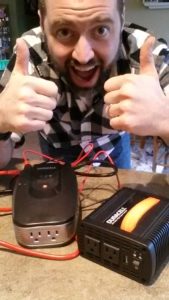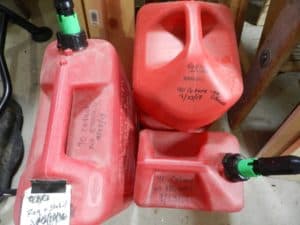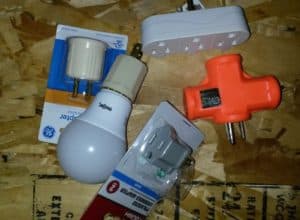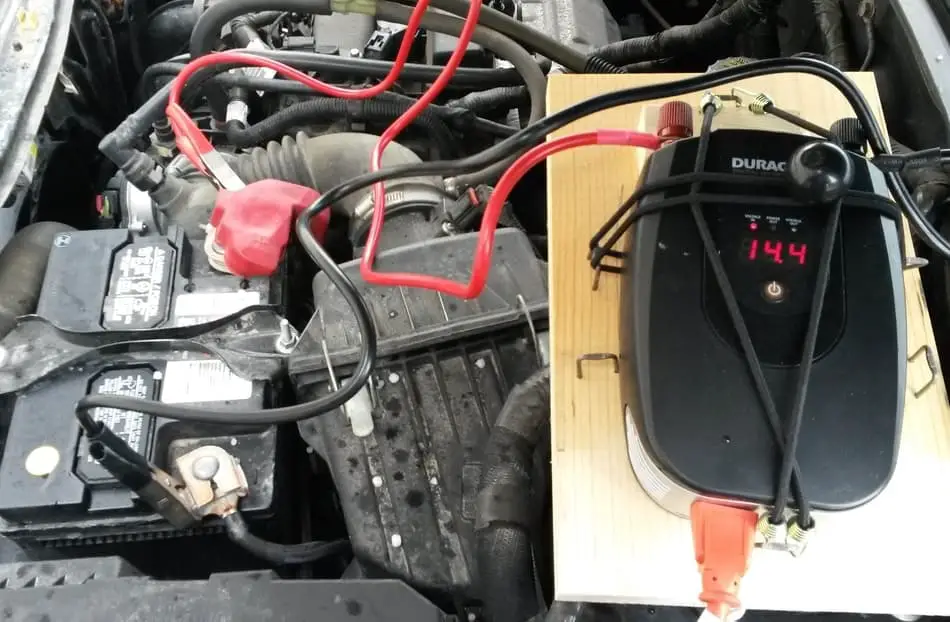What if I told you there was a simple way you could combat a power outage that would only cost you $100 or so and your car’s battery?
With just a few items and accessories, you can enter the first stage of preparedness when it comes to backup power for your house when the power goes out.
How do you use your car battery for emergency power?
To use your car battery for emergency power, a DC-to-AC power inverter may be plugged into the 12-volt accessory socket in your car for use of 150 watts or less, or connected directly to the car battery for appliances requiring above 150 watts. Total watts used must not exceed the inverter’s total rated watts.
Let’s discuss how to make it through a short-term power outage with nothing more than your car, some gas, extension cords, and a DC-to-AC power inverter. I’ll cover what you can and can’t power with your car, what you’ll need, and how to hook it up. Let’s get started!
What you’ll need
Let’s get to the basic three things that you’ll need to be successful in this endeavor. We’ll make the assumption that you have a car if you’re still reading at this point.
1. The Inverter
Personally, I have two inverters and am looking at buying a smaller one the next time I get around to it. I am currently sporting an 800watt and 400watt – both Duracell brand. They have not given me any problems whatsoever and have been great companions in power outages and when traveling. I’m not a fan of there not being a way to screw them down to something. The next one I get will likely be a Whistler or Cobra.
I’ve recently discovered the joy of using Velcro to secure my power inverters to surfaces. My love for my Duracell inverters remains intact!

- 800-1000+ Watt: These are great for the larger ticket items and then having a little wiggle room to spare. You could run a small TV off of them and still be able to have some lights on and power your devices, the modem, and router. I usually have the 800 Watt inverter hooked up the battery bank or car battery if there is a chance that we’ll be watching TV and using the 300-watt bottle warmer since we have a newborn. Having a way to provide warm milk or formula to a baby in an event like this makes you feel like Parent of the Year!
- 400 Watt: If we’re just going to have lights on, power devices and charge the computer, I use the 400 Watt inverter. Basically everything I would use the 800-watt inverter for without the television or bottle warmer. If I just want to watch television and have a couple of LED bulbs for lighting while charging my phone, the 400-watt inverter can do that as well. You just need to start getting more careful about how many watts you’re using as you reduce rated watts of the inverter.
- <400 Watt: Keep in mind that inverters use electricity too, and the cheaper ones use a lot more. If you can get a quality small one, you’ll be able to run lights and charge a device or two without putting a lot of stress on your battery. Of course, you’ll still want to start up your car from time to time for 15-30 minutes to keep the battery topped off with electricity from the alternator.
2. Gasoline
Regardless of whether or not you only plan to use your car as a backup power source, have a generator, or a dedicated battery bank, you’ll want to store extra gasoline. Some people who are really into this lifestyle can have up to 12 five gallon containers stored up. I can appreciate that but at the present time, I am content with having 6 five gallon jugs. Two of my jugs have ethanol free gasoline for my generator. The other 4 have regular gasoline for my cars, lawn mower, and generator if it gets to that point.

Having gasoline on hand allows you to get out of the area in an emergency if the gas station pumps are down. It also allows you to shelter inside your home for an extended period. You’ll be able to use your car as a generator, the generator itself, or keep your car/generator running to recharge the dedicated battery bank that you might have.
Rotation and Treatment:
You’ll want to keep in mind that gasoline is meant to be used and not stored for long periods of time. If you’re going to store it for any length of time you’ll need to treat it first. I personally now use Sea Foam and it works great for me. In the past, I have also used Stabil and never had any problems. The benefit of Sea Foam is that it cleans out your engine when you get around to using it.
As far as rotating them, I just keep a roll of duct tape near them and every time I fill one up, I label it with the type of gasoline, the date, and confirm that I’ve treated it for storage. Then after 6 months or so I dump one in my car’s gas tank and refill it with the type of gasoline that it had in it before. Put a new label on it, and the next month you pick a different jug that is now at its 6-month storage date. Lather, rinse, repeat. Don’t worry about missing a month. As long as you use them within a year you won’t have any problems.
3. Extension Cord and Accessories
This is the more mundane part of the system setup. Really, all you need are a couple of 25’ and 50’ cords to start to get your house set up. I prefer to have some 12 gauge and 14 gauge cords so that I know for sure that they can handle whatever load I’ll be using with an inverter on regular household items. Beyond the cords, you’ll want to get a half a dozen (or more) smaller household extension cords so that you can branch off the main extension cords.
You likely already have many of these things. Use 3-grounded outlet T-shaped adapters to create branching-off points. Also handy to have are 2 pronged light bulb sockets (either with or without the cord). That way you have a low watt LED light bulb that can be unplugged and plugged back in where you need it.

So what exactly can I power with my car?
Okay, the kids are starting to complain that the TV just went out. You’re worried about more adult things like food spoiling in the freezer and saving that spreadsheet on the computer. Luckily, if you did just a little bit of preparations for well under $100 you should be all set to handle such a situation. The primary wildcards in this situation will be the weather and your particular living situation when it comes to how you utilize power from your car battery.
Refrigerator?:
Keep in mind that the freezer and the refrigerator are specifically designed to stay cold. As long as you’re not constantly opening them you’ll have lots of time. After 4 hours I start to get worried and approaching 6 I like to get power to it. If you have a newer energy star refrigerator you’ll likely be able to run them with an inverter of at least 800 to 1,000 watts (more is preferred).
You’ll want to check the sticker in the fridge to get an idea of the energy usage. Remember, volts x amps = watts. Also, remember that the compressor will require a wattage surge that is far greater than the running watts and your inverter will need to be able to handle that surge.
Just remember to keep your car running while you do it and go ahead and run the freezer or refrigerator for an hour or two every 6 hours or so. Keep in mind as well that the type of inverter you use (modified vs true sine wave) can have an impact on the motor of your refrigerator and damage it. True sine wave inverters are more expensive but are worth it if you can afford it and they will provide your appliances with the cleanest power.
Since I own modified sine wave inverters, I do not attempt to run my fridge with my car and would only attempt it if the grid were down due to a natural disaster and I didn’t see the prospect of power returning for a long time. Most of the outages in my area last from a few hours to a few days. It’s not worth the risk to me to gamble with the life of my refrigerator when the value of the food inside doesn’t justify it.
Bonus Tips for Keeping Food Cold During a Power Outage:
- When times are good and you have power, use up empty space in your freezer with jugs and bottles of water. The water will freeze and you’ll have a giant ice-packs of various sizes. When the power goes out, simply remove an ice-pack from the freezer and put it in the refrigerator to keep it cool until you get the power sorted out. Also, you’ll use less energy and save money on your power bills since the freezer won’t be working to keep the extra space cold and the frozen water bottles will help keep the entire freezer cold themselves!
- When the power goes out, and you move some of the ice bottles/jugs to the fridge, move the dairy and fast spoiling items in the fridge to the freezer. You’ll extend the viability of everything that way.
- Use extra blankets and pile them on and around freezers and refrigerators for extra insulation.
- If your power goes out in the winter, take advantage of the cold. If you have snow outside, fill up coolers with them and put items inside as well.
What appliances can I power with my car battery?
Now, basic things like low wattage LED lights, mobile devices, AA and AAA battery chargers and even a TV can all be powered by using an inverter on your car battery. If you’re going to be running just lights and powering low-wattage devices (150 or less), I recommend starting your car up every 45-60 minutes for 20-30 minutes at a time to keep the battery topped off.
Remember, the car battery is not a deep cycle battery. If you’re looking to run the TV, or another device that requires a moderate amount of watts (above 150 to the rated watts of the inverter), you’ll want to run the car while using the battery during those times.
You should not attempt to power high-wattage items such as blow dryers, microwaves, coffee makers, etc. These just push the battery and inverter beyond the point of what they are designed to handle. Remember, we have a mini, makeshift generator also known as your car. We’re just using it to provide for basic lighting and charging media devices and your rechargeable batteries for your flashlights until we get things sorted out.
Setting up the Inverter:

If it’s raining, I pull my car partially into the garage with the tailpipe outside. If you don’t have a garage or cover for your car, you’ll want to wait until the storm passes since your inverter does not want to get wet. Once you have the car in a safe environment, pop the hood and locate the battery.
With the car off, simply connect the red cord of the inverter to the positive terminal of the battery, and connect the black cord to the negative terminal. Then start up the car, and power-on your inverter. I give it a minute or so before I put a load on it. When it’s ready, simply plug in an extension cord into it and the rest is what you would normally do with any appliance inside the house.
Many inverters will allow you to check the display to see how much energy is being produced and used. When you’re done, unplug the extension cord from the inverter, turn off the inverter, turn off the car and disconnect the inverter.
A tip for using the inverter under the hood is to mount the inverter to a board (with self-adhesive Velcro if it doesn’t have mounting points) to give it something to sit on so that it’s not directly on something hot with the engine. Also, the board helps to prevent the inverter from falling and having something touch both terminal cables where they connect to the inverter which would create a short and fry your unit.
Those are the basics for getting a simple set-up going for emergency power from your car! If you’re not prepared for a power outage at all, you should be able to get most of the items you need in this article for well under $100. From there, if you are interested in a dedicated battery backup system, you can check out other articles on this site and save up for the next blackout so that you can coast through it in style! Trust me, when you get properly prepared, you get a feeling of relief and excitement and almost wish for a short-term power outage just to test your preparations!

